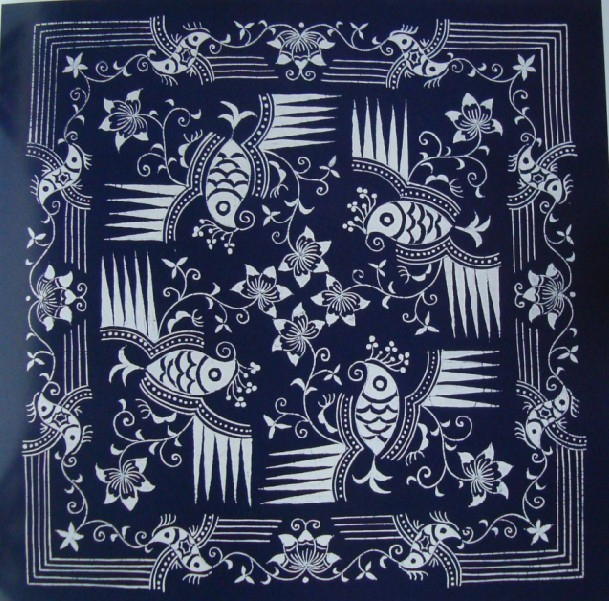
Dongba Batik in Lijiang
Introduction to Dongba Batik
Dongba Batik is a unique and culturally significant craft of the Naxi people in Lijiang, Yunnan Province. It combines traditional batik techniques with the rich cultural elements of the Dongba culture, creating beautiful and meaningful textile art. This traditional craft is not only a form of artistic expression but also an important part of the cultural heritage of the Naxi people.
Cultural Background
Dongba culture is deeply rooted in the history and traditions of the Naxi people. The term “Dongba” refers to the Naxi priests who are masters of traditional culture, literature, and the Dongba script. Dongba Batik incorporates symbols and motifs from Dongba paintings and scriptures, which often depict deities, animals, and scenes from nature. These elements reflect the Naxi people’s reverence for nature and their spiritual beliefs.
Craftsmanship Process
The process of creating Dongba Batik involves several traditional steps:
-
Design and Drawing: Artisans first draw traditional Dongba motifs and symbols onto the fabric. These designs are often inspired by Dongba paintings and religious texts.
-
Wax Application: Using a special wax tool, artisans apply hot wax to the areas of the fabric that are to remain un-dyed. This step is crucial in creating the intricate patterns.
-
Dyeing: The fabric is then immersed in natural dyes, typically blue or indigo, to achieve the desired color. The wax prevents the dye from penetrating the waxed areas, preserving the original color of the fabric.
-
Wax Removal: After the dyeing process, the wax is removed by boiling the fabric. This reveals the intricate patterns and designs that were protected by the wax.
Artistic Features
Dongba Batik is known for its:
-
Intricate Patterns: The designs often include complex geometric shapes, animals, and symbolic figures from Dongba culture.
-
Natural Dyes: Traditional Dongba Batik uses natural indigo and other plant-based dyes, giving the fabric a rich and deep color.
-
Cultural Significance: Each piece of Dongba Batik tells a story or represents a cultural belief, making it more than just a decorative item.
Modern Applications
Today, Dongba Batik is used in a variety of ways:
-
Traditional Clothing: Many Naxi people still wear garments made from Dongba Batik, especially during festivals and special occasions.
-
Home Decor: Dongba Batik is also popular for home decor items such as tablecloths, cushions, and wall hangings.
-
Souvenirs and Gifts: Visitors to Lijiang often purchase Dongba Batik products as souvenirs or gifts, helping to support local artisans and preserve this traditional craft.
Dongba Batik is a beautiful and meaningful craft that reflects the rich cultural heritage of the Naxi people. It continues to be an important part of their cultural identity and a cherished art form in Lijiang.



 7 Days GolfingTour
7 Days GolfingTour
 8 Days Group Tour
8 Days Group Tour
 8 Days Yunnan Tour
8 Days Yunnan Tour
 7 Days Shangri La Hiking
7 Days Shangri La Hiking
 11 Days Yunnan Tour
11 Days Yunnan Tour
 6 Days Yuanyang Terraces
6 Days Yuanyang Terraces
 11 Days Yunnan Tour
11 Days Yunnan Tour
 8 Days South Yunnan
8 Days South Yunnan
 7 Days Tea Tour
7 Days Tea Tour
 8 Days Muslim Tour
8 Days Muslim Tour
 12 Days Self-Driving
12 Days Self-Driving
 4 Days Haba Climbing
4 Days Haba Climbing
 Tiger Leaping Gorge
Tiger Leaping Gorge
 Stone Forest
Stone Forest
 Yunnan-Tibet
Yunnan-Tibet
 Hani Rice Terraces
Hani Rice Terraces
 Kunming
Kunming
 Lijiang
Lijiang
 Shangri-la
Shangri-la
 Dali
Dali
 XishuangBanna
XishuangBanna
 Honghe
Honghe
 Kunming
Kunming
 Lijiang
Lijiang
 Shangri-la
Shangri-la
 Yuanyang Rice Terraces
Yuanyang Rice Terraces
 Nujiang
Nujiang
 XishuangBanna
XishuangBanna
 Spring City Golf
Spring City Golf
 Snow Mountain Golf
Snow Mountain Golf
 Stone Mountain Golf
Stone Mountain Golf



